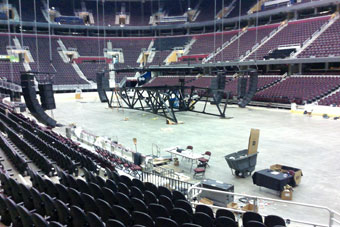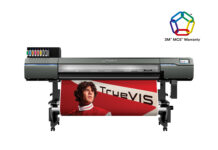Those watching last summer’s NBA Finals between the Cleveland Cavaliers and eventual-champion Golden State Warriors either in the stands or at home not only witnessed a performance of the ages from Cavs star LeBron James, but when action during the best-of-seven series shifted to Cleveland’s home court, Quicken Loans Arena, they may have also seen one of the most innovative scoreboards in the country on display.
Quicken Loans Arena (the “Q”) boasts a seating capacity of 20,562, and before the start of the 2014-15 NBA season, the Cavaliers organization wanted to enhance the atmosphere and experience inside with digital signage. The Q now features more than 11,682 square feet of LED displays that include four corner boards, 360-degree fascia ribbon in the seating area, and the replacement of traditional backlit signage on the concourses with thirty-one high-resolution LED displays.
The centerpiece of this makeover: A 5,550-square foot, LED display/scoreboard center-hung eighty-five feet in the air that features tilted/curved angles.
ANC Sports, a provider of integrated signage, design, and marketing solutions for sports and commercial facilities, was awarded the opportunity to design, build, and oversee the installation of this electronic signage overhaul.
In fact, the Cavaliers were one of ANC Sports’s first LED signage customers back around the turn of the Millennium (when their home facility was known as Gund Arena). ANC Sports had installed their previous center-hung scoreboard, as well as other ancillary displays.
“The Cavs wanted to push the industry and the LED video display design concepts to something ‘outside the box,’” says Christopher Mascatello, executive vice president, Technology Sales and Services, at ANC Sports.
The Cavaliers wanted everyone attending to be able to see the scoreboard display clearly and cleanly. This meant thinking beyond the typically used first- and second-generation rectangular scoreboards.
The ANC Sports team considered the highest-paying customer in the building (those with courtside seats). “When people are paying $1,000, $5,000, and $10,000 a ticket,” says Mascatello, “giving them a six-by-twelve-foot screen on the underside of a mega-scoreboard seemed counter-intuitive.”
But ANC Sports wanted to make sure the viewing experience was also ideal for those in the upper levels. “Some of the previous designs utilized a big I-beam design, which meant that, for those in the upper corners of the building, the screens on the baseline would obstruct a significant portion of the sidelines,” explains Mascatello.
The center-hung scoreboard sports four enormous HD video screens that are tilted and uniquely curved to provide optimal viewing angles for all fans. The two sideline screens measure 31.50 feet high-by-56.69 feet wide, while the two high-resolution baseline screens measure 29.92 feet high-by-33.07 feet wide.
To arrive at this solution, ANC Sports designers collaborated with engineers and installers and made a couple of survey visits. Doing so, they realized the need to follow a set schedule (design, content creation, installation, etc.).

This set schedule proved important as the clock was ticking: The scoreboard needed to be up and running in less than two-and-a-half months (instead of the normal five), in time for the Cavs’ first home game of the season.
ANC Sports first modeled the stadium—including forty-some seating position to use as evaluation criteria—using CAD and other 3D software and then added 3D renderings of the proposed scoreboard in the designs.
This led to some interesting ideas that had never been accomplished before.
“The sideline screens are angled down significantly more than a traditional scoreboard—about six degrees,” says Mascatello. “By angling them in, we could also slightly raise the baseline screens above the center point a bit and cut down on the amount of screen obstruction.”
Mascatello compares the “pronounced curve” concept to how they’re used in IMAX® and 70mm movie theaters.
“At some point, the screen can get so big that it extends beyond the periphery of human eye, leading to wasted information,” he explains. “But these theaters have figured out that curving the screen allows a more visible image with the same canvas of x-number of pixels and total length as if straightened out.”
However the uniform curve is an optical illusion—it’s a series of straight lines with subtle “bends” to them. “A degree-and-a-half at each cabinet,” says Mascatello.
ANC Sports had to make sure there were no gaps in the cabinets themselves. They used automated bending machines, sheet metal cutting, and CNC routers for certain pieces, knowing they could manufacture the displays and cabinets so that the angle was consistent from cabinet to cabinet (and even within the cabinet).
The company also partnered with a number of groups they’d worked with before in fabrication and installation to make sure they could ensure that tolerances were met.
The narrowness of the new scoreboard (the bottoms of the screens are only about four to five feet wide) allowed ANC Sports to remove a fair amount of internal structure from it—helping to meet the fast-approaching due date. “This allowed us to keep weight off the center-hung,” says Mascatello, “meaning we didn’t have to reinforce the roof, put in a new hoist, and things like that.”
Speaking of the tight schedule, ANC Sports earmarked certain milestones.
The first milestone involved removing the old scoreboard first (“demolition”). The second was getting the large structure built properly to tight specifications, so the cabinets would be seamless.
The next milestone was populating the center-hung structure frame with the video and the LED panels. “Once the hoist was working, we could bring it up and down as we wanted,” says Mascatello. “A lot of times, this took twenty-hour shifts.”
Arena officials wanted to make this new LED display a surprise, so they didn’t announce it to the public. But other events, such as concerts, were going on at times inside the arena. On those nights, installers would shroud the structure in black fabric scrim and hoist it back to the ceiling. Then when the event was over, they’d drop the scrim, lower the display, and return to populating the panels.
The video screens feature sponsor advertisements, video replays, player information, crowd prompts, etc. It also features a state-of-the-art audio/visual system (advanced audio digital processing, six-line array speaker clusters, etc.) designed and installed by Parsons Audio.
The new display also incorporates one iconic piece from the previous center-hung—a liquid fuel flame shooter with movable swords that drop down from each of the four corners of the scoreboard to fire up the fans and team.
“They’re real flames, so this required coordination with the fire marshal for inspections,” says Mascatello, noting that since the flames shoot out from the corners away from the screen, there are “zero issues” with the plastics and electronics being affected.
The finished scoreboard debuted on the Cavaliers’ first game last October 30, earning winning reviews.
So are curved screens the future? “You really build around what each facility is trying to accomplish,” says Mascatello. “But I do think the industry and the market are seeing that just a square cube or rectangular box isn’t going to work.”
In other words, game on!
By Jeff Wooten
All Photos: ANC Sports











